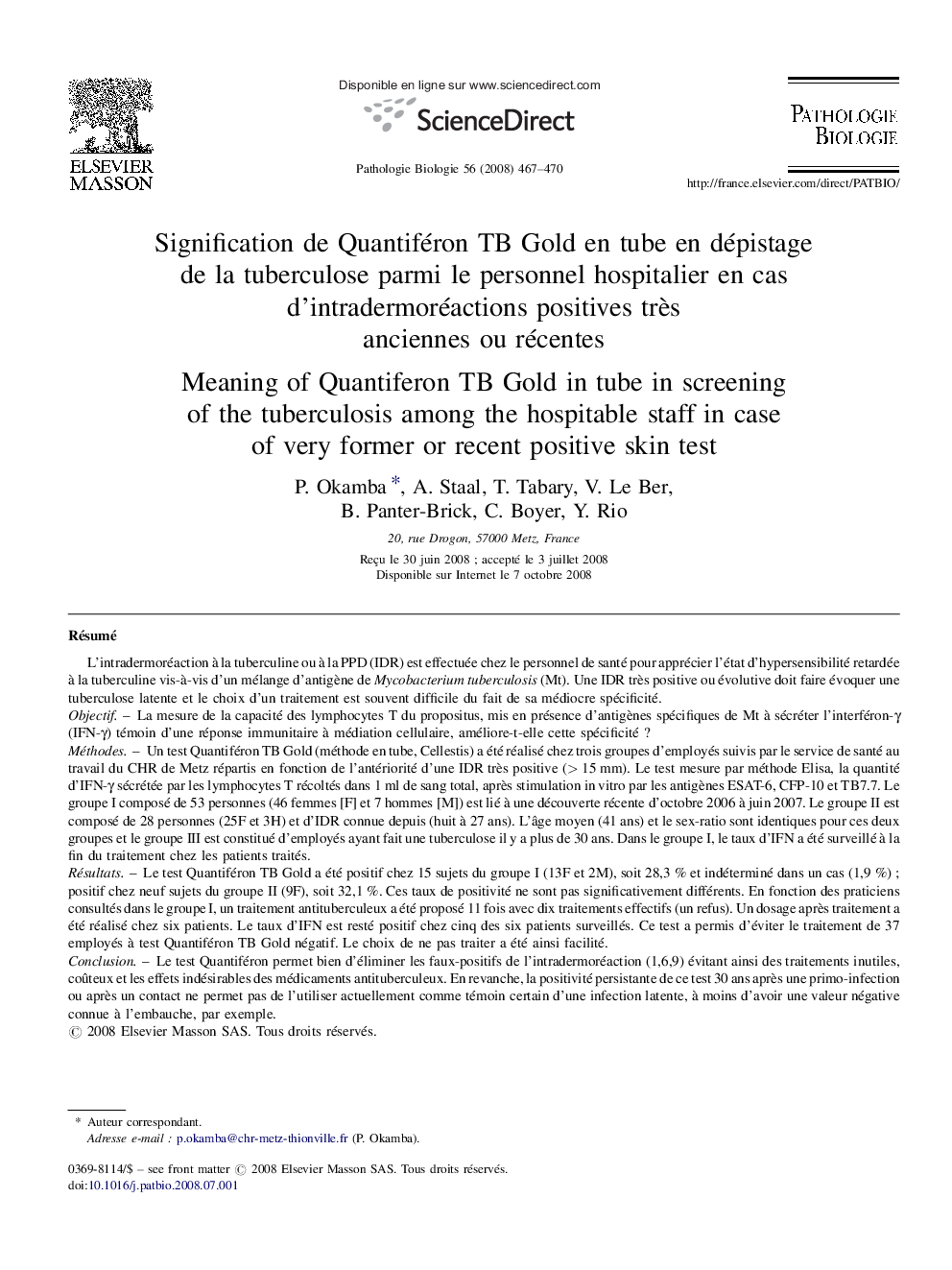| کد مقاله | کد نشریه | سال انتشار | مقاله انگلیسی | نسخه تمام متن |
|---|---|---|---|---|
| 4136383 | 1606681 | 2008 | 4 صفحه PDF | دانلود رایگان |

RésuméL’intradermoréaction à la tuberculine ou à la PPD (IDR) est effectuée chez le personnel de santé pour apprécier l’état d’hypersensibilité retardée à la tuberculine vis-à-vis d’un mélange d’antigène de Mycobacterium tuberculosis (Mt). Une IDR très positive ou évolutive doit faire évoquer une tuberculose latente et le choix d’un traitement est souvent difficile du fait de sa médiocre spécificité.ObjectifLa mesure de la capacité des lymphocytes T du propositus, mis en présence d’antigènes spécifiques de Mt à sécréter l’interféron-γ (IFN-γ) témoin d’une réponse immunitaire à médiation cellulaire, améliore-t-elle cette spécificité ?MéthodesUn test Quantiféron TB Gold (méthode en tube, Cellestis) a été réalisé chez trois groupes d’employés suivis par le service de santé au travail du CHR de Metz répartis en fonction de l’antériorité d’une IDR très positive (> 15 mm). Le test mesure par méthode Elisa, la quantité d’IFN-γ sécrétée par les lymphocytes T récoltés dans 1 ml de sang total, après stimulation in vitro par les antigènes ESAT-6, CFP-10 et TB7.7. Le groupe I composé de 53 personnes (46 femmes [F] et 7 hommes [M]) est lié à une découverte récente d’octobre 2006 à juin 2007. Le groupe II est composé de 28 personnes (25F et 3H) et d’IDR connue depuis (huit à 27 ans). L’âge moyen (41 ans) et le sex-ratio sont identiques pour ces deux groupes et le groupe III est constitué d’employés ayant fait une tuberculose il y a plus de 30 ans. Dans le groupe I, le taux d’IFN a été surveillé à la fin du traitement chez les patients traités.RésultatsLe test Quantiféron TB Gold a été positif chez 15 sujets du groupe I (13F et 2M), soit 28,3 % et indéterminé dans un cas (1,9 %) ; positif chez neuf sujets du groupe II (9F), soit 32,1 %. Ces taux de positivité ne sont pas significativement différents. En fonction des praticiens consultés dans le groupe I, un traitement antituberculeux a été proposé 11 fois avec dix traitements effectifs (un refus). Un dosage après traitement a été réalisé chez six patients. Le taux d’IFN est resté positif chez cinq des six patients surveillés. Ce test a permis d’éviter le traitement de 37 employés à test Quantiféron TB Gold négatif. Le choix de ne pas traiter a été ainsi facilité.ConclusionLe test Quantiféron permet bien d’éliminer les faux-positifs de l’intradermoréaction (1,6,9) évitant ainsi des traitements inutiles, coûteux et les effets indésirables des médicaments antituberculeux. En revanche, la positivité persistante de ce test 30 ans après une primo-infection ou après un contact ne permet pas de l’utiliser actuellement comme témoin certain d’une infection latente, à moins d’avoir une valeur négative connue à l’embauche, par exemple.
The tuberculin skin test or PPD performed on health professionals evaluates delayed hypersensitivity to a Mycobacterium tuberculosis (Mt) antigen mixture. A very positive or increased area of induration indicates latent tuberculosis. Yet, prescribing a treatment is often difficult because of the test’s poor specificity.ObjectiveTo determine if the T-lymphocytes of the proband exposed to specific Mt antigens to secrete interferon-γ (IFN-γ) can be measured; observe an immunizing response to cellular mediation improves T it this specificity?Patients and methodsThe Department of Occupational Health at CHR of Metz performed a Quantiferon TB Gold (tube method, Cellestis) test on three groups of employees distributed according to the anteriority of a very positive IDR (> 15 mm). The test measures by method ELISA, the quantity of IFN-γ secreted by the lymphocytes T collected in 1 ml of total blood, after in vitro stimulation by antigens ESAT-6, CFP-10 and TB7.7. Group I is composed of 53 people (46 women [W] and 7 men [M]) and related to a recent discovery of October 2006 and June 2007, whereas group II, includes 28 of them (25W and 3M), is made of subjects with known very positive PPD for eight to 27 years. The age (41 years on average) and the sex-ratio are identical for these two groups. Group III is made of employees having made a tuberculosis there is more than 30 years. In the group I, the rate of IFN was supervised at the end of the treatment among patients who received it.ResultsThe test Quantiferon TB Gold was positive at 15 subjects of group I (13W and 2M), that is to say 28.3%, and unspecified in one case (1.9%); positive at nine subjects of group II (9W), that is to say 32.1%. These rates of positivity are not significantly different. According to the experts consulted in group I, an antituberculosis treatment was proposed 11 times with 10 effective treatments (one refusal). A proportioning after treatment was carried out among six patients. The rate of IFN remained positive at five of the six supervised patients. This test made it possible to avoid the treatment of the 37 employees with test Quantferon TB negative Gold found over the nine months period of recruitment of group I. The choice not to treat was facilitated.ConclusionThe test Quantiferon indeed allows to eliminate the false positive of the skin test (1.6) so avoiding useless, expensive treatments and unwanted effects of antituberculosis medicines . On the other hand, the persistent positivity of this test 30 years after one firstly infection or after a contact does not allow to use it at present as certain control of a latent infection, unless having a negative value known about the hiring pa.
Journal: Pathologie Biologie - Volume 56, Issues 7–8, November–December 2008, Pages 467–470